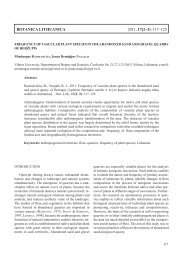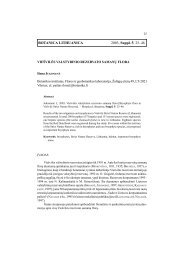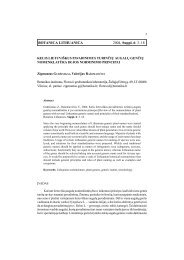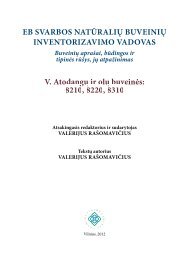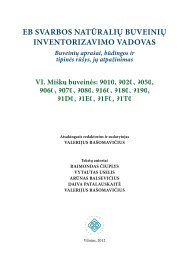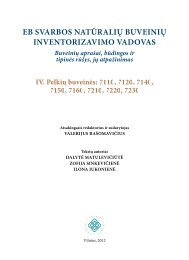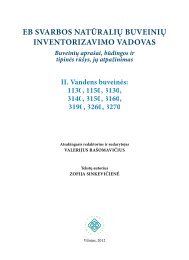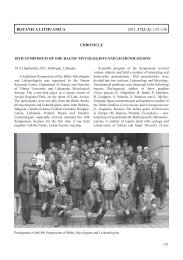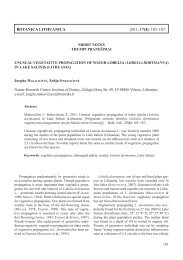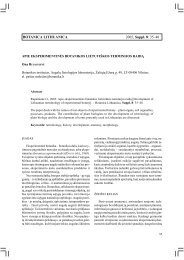FUNGI AND LICHENS IN THE BALTICS AND BEYOND XVIII ...
FUNGI AND LICHENS IN THE BALTICS AND BEYOND XVIII ...
FUNGI AND LICHENS IN THE BALTICS AND BEYOND XVIII ...
Create successful ePaper yourself
Turn your PDF publications into a flip-book with our unique Google optimized e-Paper software.
North America. Presence of this fungus in alder species from different subgenera (i.e. Alnus<br />
and Alnobetula (Ehrh.) Peterm.) is an evidence of absence of species-specificity of the<br />
pathogen and likelihood of its occurrence in other species.<br />
The study of pathogenic mycobiota of leaves in natural alder populations revealed its<br />
significant diversity. A complex of micromycetes was found on leaves of A. fruticosa Rupr.<br />
in the nature reserve “Stolby” (Krasnoyarsk, Russia). Melampsoridium alni (Thum.) Dietel<br />
and Microsphaera penicillata (Wallr. : Fr.) Lev. were found on the lower side of leaves.<br />
Uredospori of rust fungi were damaged by hyperparasite Ramularia uredinis (W. Voss) Sacc.<br />
(a new host for this Ramularia). A new species of sporodochial hyphomycete Cheiromycella<br />
foliicola U. Braun, Melnik & Tomoshevich, sp. nov. was found on the upper side of leaves.<br />
Acknowledgements. This work was partly supported by the Council of the city<br />
Novosibirsk (grant № 35-10).<br />
<strong>IN</strong>VESTIGATION OF Venturia inaequalis POPULATION <strong>IN</strong> DIFFERENT<br />
AGROECOSYSTEMS<br />
A. VALIUŠKAITĖ*, E. SURVILIENĖ, D. BANIULIS<br />
Institute of Horticulture, Lithuanian Research Centre for Agriculture and Forestry, Kauno 30,<br />
Babtai, Kaunas distr., Lithuania<br />
E-mail: a.valiuskaite@lsdi.lt<br />
The aim of the present study is to assess the variation of genetic structure of Venturia<br />
inaequalis isolates originating from different agroecosystems. Specimens were collected from<br />
Anykščiai, Biržai, Kaunas, Panevėžys, Pasvalys regions. Samples were collected from fruits<br />
and leaves with characteristic symptoms of Venturia inaequalis infection grown at different<br />
locations, average 10 specimens per region. Fungal cultures were established using wet<br />
chamber and growth on solid medium methods and assessed microscopically. Isolates were<br />
grown on Potato dextrose agar pH 5.0 (PDA) (Merck KGaA) at 20 ± 2°C in the dark for 2–3<br />
weeks, and identified according to fungal identification manuals. AFLP samples were<br />
prepared using AFLP Microbial fingerprinting kit (“Applied Biosystems” Ltd.) using<br />
manufacturer instructions based on method described by Vos et al. (1995). Allele scoring was<br />
performed using Gene Mapper v.4.0 (“Applied Biosystems” Ltd.). The scoring parameters of<br />
50 to 500 bp range and higher than 50 rfu signal intensity was used. To assess genetic<br />
distance of different isolates, cluster analysis was performed on Systat v.13 software (“Systat<br />
Software” Ltd.) using hierarchical analysis algorithm of χ 2 distance.<br />
An assessment of genetic polymorphism of the 22 selected Venturia inaequalis<br />
isolates using AFLP method with three pairs of primers with one selective nucleotide resulted<br />
in identification of 630 polymorphic alleles. Cluster analysis of genetic similarity of the<br />
isolates revealed seven distinct groups with genetic distance value less than 0.5. A high<br />
genetic polymorphism characterized different geographical areas. It was found that genetic<br />
diversity was characteristic of geographic area boundaries. Genetic groups with genetic<br />
similarity were associated with a common origin of the planting material.<br />
Acknowledgements. The study was supported by the Research Council of Lithuania<br />
(Acronym GENŪKIS, 2008–2009).



